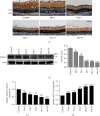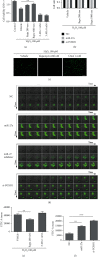MicroRNA-27a Promotes Oxidative-Induced RPE Cell Death through Targeting FOXO1
- PMID: 34761005
- PMCID: PMC8575620
- DOI: 10.1155/2021/6666506
MicroRNA-27a Promotes Oxidative-Induced RPE Cell Death through Targeting FOXO1
Abstract
Age-related macular degeneration (AMD) is a multifactor disease, which is primarily characterized by retinal pigment epithelium (RPE) cell loss. Since the retina is the most metabolically active tissue, RPE cells are exposed to consistent oxidative environment. So, oxidation-induced RPE cell death has long been considered a contributor to the onset of AMD. Here, we applied a retinal degeneration (RD) rat model induced by blue light-emitting diode (LED) and a cell model constructed by H2O2 stimulus to mimic the prooxidant environment of the retina. We detected that the expression of miR-27a was upregulated and the expression of FOXO1 was downregulated in both models. So, we furtherly investigated the role of miR-27a-FOXO1 axis in RPE in protesting against oxidants. Lentivirus-mediated RNA was injected intravitreally into rats to modulate the miR-27a-FOXO1 axis. Retinal function and histopathological changes were evaluated by electroretinography (ERG) analysis and hematoxylin and eosin (H&E) staining, respectively. Massive photoreceptor and RPE cell death were examined by terminal deoxynucleotidyl transferase-mediated dUTP nick end labeling (TUNEL). The damage to the retina was aggravated in the FOXO1 gene-knockdown and miR-27a-overexpression groups after exposure to LED but was alleviated in the FOXO1 gene-overexpression or miR-27a-knockdown groups. Dual luciferase assay was used to detect the binding site of miR-27a and FOXO1. Upregulated miR-27a inhibited the expression of FOXO1 by directly binding to the FOXO1 mRNA 3'UTR and decreased the autophagy activity of ARPE-19 cells, resulting in the accumulation of reactive oxygen species (ROS) and decrease of cell viability. The results suggest that miR-27a is a negative regulator of FOXO1. Also, our data emphasize the prominent role of miR-27a/FOXO1 axis in modulating ROS accumulation and cell death in RPE cell model under oxidative stress and influencing the retinal function in the LED-induced RD rat model.
Copyright © 2021 Chengda Ren et al.
Conflict of interest statement
The authors declare that they have no conflicts of interest.
Figures







Similar articles
-
miR-25 Mediates Retinal Degeneration Via Inhibiting ITGAV and PEDF in Rat.Curr Mol Med. 2017;17(5):359-374. doi: 10.2174/1566524018666171205122540. Curr Mol Med. 2017. PMID: 29210651
-
17β-estradiol ameliorates oxidative stress and blue light-emitting diode-induced retinal degeneration by decreasing apoptosis and enhancing autophagy.Drug Des Devel Ther. 2018 Sep 4;12:2715-2730. doi: 10.2147/DDDT.S176349. eCollection 2018. Drug Des Devel Ther. 2018. PMID: 30233136 Free PMC article.
-
MicroRNA-24 protects retina from degeneration in rats by down-regulating chitinase-3-like protein 1.Exp Eye Res. 2019 Nov;188:107791. doi: 10.1016/j.exer.2019.107791. Epub 2019 Sep 3. Exp Eye Res. 2019. PMID: 31491426
-
Retinal Pigment Epithelium Under Oxidative Stress: Chaperoning Autophagy and Beyond.Int J Mol Sci. 2025 Jan 30;26(3):1193. doi: 10.3390/ijms26031193. Int J Mol Sci. 2025. PMID: 39940964 Free PMC article. Review.
-
Oxidative Stress Regulation and DJ-1 Function in the Retinal Pigment Epithelium: Implications for AMD.Adv Exp Med Biol. 2018;1074:3-9. doi: 10.1007/978-3-319-75402-4_1. Adv Exp Med Biol. 2018. PMID: 29721921 Review.
Cited by
-
The Essential Role of Light-Induced Autophagy in the Inner Choroid/Outer Retinal Neurovascular Unit in Baseline Conditions and Degeneration.Int J Mol Sci. 2023 May 19;24(10):8979. doi: 10.3390/ijms24108979. Int J Mol Sci. 2023. PMID: 37240326 Free PMC article. Review.
-
Decrease of alpha-crystallin A by miR-325-3p in retinal cells under blue light exposure.Mol Cells. 2024 Aug;47(8):100091. doi: 10.1016/j.mocell.2024.100091. Epub 2024 Jul 10. Mol Cells. 2024. PMID: 38997088 Free PMC article.
-
Serum miRNA modulations indicate changes in retinal morphology.Front Mol Neurosci. 2023 Mar 3;16:1130249. doi: 10.3389/fnmol.2023.1130249. eCollection 2023. Front Mol Neurosci. 2023. PMID: 36937046 Free PMC article.
-
Oxidative Stress and Epigenetics: miRNA Involvement in Rare Autoimmune Diseases.Antioxidants (Basel). 2023 Mar 25;12(4):800. doi: 10.3390/antiox12040800. Antioxidants (Basel). 2023. PMID: 37107175 Free PMC article. Review.
-
Autophagy Activation Promoted by Pulses of Light and Phytochemicals Counteracting Oxidative Stress during Age-Related Macular Degeneration.Antioxidants (Basel). 2023 May 30;12(6):1183. doi: 10.3390/antiox12061183. Antioxidants (Basel). 2023. PMID: 37371913 Free PMC article. Review.
References
MeSH terms
Substances
LinkOut - more resources
Full Text Sources
Research Materials
Miscellaneous

